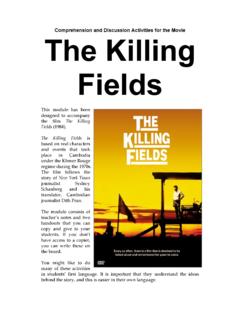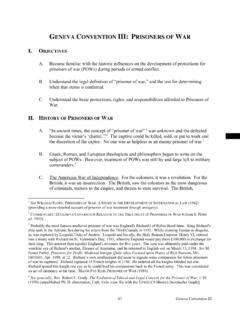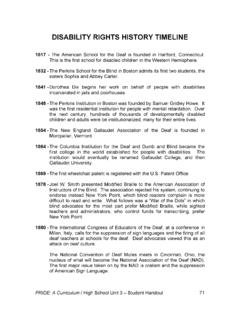Transcription of Comprehension and Discussion Activities for the Movie …
1 Comprehension and Discussion Activities for the Movie Gandhi This module has been designed to accompany the film Gandhi (1982). Gandhi is based on real characters and events that took place between 1893 and 1948 . Mahatma Gandhi was an Indian lawyer who first organized non-violent protests while he was living in South Africa. In 1915, Gandhi returned to India. For the next 30 years, he led the people of India in a non-violent civil disobedience campaign to fight for India s independence from the British. Gandhi also struggled for women s rights and for Hindu-Muslim unity. Gandhi is the story of these struggles. The module consists of teacher s notes and two handouts that you can copy and give to your students. If you don t have access to a copier, you can write these on the board. You might like to do many of these Activities in students first language. It is important that they understand the ideas behind the story, and this is easier in their own language.
2 Teacher s Notes 1. Before You Watch : India and Gandhi Brainstorm Give copies of Worksheet 1: Background Information to your students Ask students what they know about India. Where is it? What is the culture like? Have students brainstorm anything they know. Write their answers on the board. Do another brainstorm about Gandhi. Who was he? What did he do? Again, write the students answers on the board. Discuss the photographs with students: Clockwise from top: Gandhi with some of his followers Gandhi as a young man with his wife, Ba Gandhi s funeral procession Gandhi and Jawaharlal Nehru, India s first Prime Minister Read through the background information with students. : Vocabulary With students, read through the vocabulary definitions in Worksheet 1. Discuss each word as it appears in the background information to make sure students fully understand the meanings.
3 After reviewing vocabulary definitions, tell students to complete Exercise A. Answers: 1. F India is a mostly Hindu country. 2. T 3. F The caste system still exists, but caste-based discrimination is against the law. 4. F British colonial rule lasted almost 100 years. 5. T 6. F The Indian independence movement succeeded in 1947. 7. F There was already racial separation in South Africa before apartheid. 8. T Teacher s Notes 2. While You Watch : Discrimination in South Africa Give copies of Worksheet 2: While You Watch to your students, or write the questions for on the board. Play the film to Answers to Exercise A: 1. The man on the train tells Gandhi that there are no coloured attorneys in South Africa. 2. Gandhi and Mr. Khan decide to protest discrimination against Indians. 3. Gandhi encourages the crowd to burn their passes.
4 4. A British policeman beats Gandhi while he burns the passes. 5. General Smuts meets with Mr. Walker, an American journalist. 6. Charlie Andrews is a British missionary who visits Gandhi. 7. When Gandhi arrives at his office, he is told that the pass laws will be changed. Exercise B: 1. a) Mr. Singh b) Gandhi was shocked to hear of such inhuman treatment, and angry at the discrimination. c) Gandhi is surprised because he is a well-educated lawyer, like the other Indian man he is speaking to, but they are still considered inferior and not allowed to walk with white men in the street. Gandhi received his law degree in England, yet the British discriminate against him in South Africa. Gandhi thinks this treatment is unjust. 2. a) Mr. Khan b) A barrister is a lawyer who represents clients in court. c) Mr. Khan is encouraging Gandhi to protest against the discrimination against Indians.
5 Mr. Khan is agreeing to join Gandhi in his protests. : Protests for Indian Civil Rights Play the film to If students don t have Worksheet 2, write the exercises on the board before you play the film. Answers to Exercise A: 1. Mr. Walker, the journalist. 2. Because in India, cleaning the latrine is the work of the untouchables. 3. The Indian miners. 4. Because all the protesters lie down. 5. General Smuts agrees to cancel the new laws and free the protesters, but all future Indian immigration will stop. Teacher s Notes Exercise B: 1. T 2. F The new laws say that a policeman may enter an Indian house and demand to see the card of any Indian woman living there. 3. F Gandhi says they should be non-violent and not cooperate. 4. T 5. F When Charlie Andrews speaks about Gandhi during his sermon at church, the people do not want to listen, and most of them leave.
6 6. T Exercise C: 1. a) Gandhi. b) Gandhi explains that non-violent civil disobedience means that you must be willing to die for the cause. It also means that the British will not be able to get what they want they want obedience, not dead bodies. 2. a) Ba said this to Gandhi. b) Gandhi was angry because Ba said she would not clean the latrine (toilet). She said it is the work of the untouchables. Gandhi gets angry because he wants to erase the idea of untouchables and he wants everyone to be equal. Exercise D: 1. Students should discuss if they think it is brave or foolish to not fight back when someone hurts you, and what makes non-violent non-cooperation effective. 2. Students should discuss traditions they have, and how they would feel if they realised the traditions were not fair. : Understand the Poor of India Play the film to If students don t have Worksheet 2, write the exercises on the board before you play the film.
7 Answers to Exercise A: 1. Gandhi arrives in Bombay, India by boat. 2. Gandhi travels for one year by train and by foot to see the countryside of India. 3. While Gandhi is on the train, he sees an English soldier who was killed by an Indian insurgent. 4. When Gandhi is making a speech, he says that politics of the people are limited to bread and salt. 5. Gandhi asks why the poor would give their loyalty to the rich, because the rich only want to take over the role of the British. 6. Nehru brings his friends to visit Gandhi at his ashram. Teacher s Notes Exercise B: 1. Nehru 2. Professor Gokhale 3. Jinnah 4. Gandhi 5. Patel : Resistance Begins Play the film to If students don t have Worksheet 2, write the exercises on the board before you play the film. Answers to Exercise A: 3, 1, 5, 4, 6, 2 Exercise B: 1. Because their British landlords ordered them to grow certain crops such as indigo, but then the British stopped buying the indigo.
8 The farmers were left with crops they could not sell, no money to eat, and no money to pay rent to the British landowners. 2. Charlie looks sad and a little confused, but he seems to understand Gandhi s reasons. 3. Gandhi asks them to gather a lot of evidence so they can win a court case against the British landowners. 4. The farmers want rebates on the rent they paid, the freedom to choose the crops they grow, and a part-Indian commission that will listen to their farming problems. 5. Because if all the Indians stop working to pray and fast, everything in India will come to a halt. This will have the effect of a general strike. 6. Because he fears rioting. He agrees to release Gandhi on the condition that Gandhi makes a speech about non-violence. 7. He says that he was trying to teach all of India a lesson. He says it is irrelevant that there were women and children at the rally.
9 Exercise C: Students should discuss the strength required to continue a campaign of non-violence when the response is so savage and violent. Let students discuss the contrast between the Indian strategy and the British strategy. Teacher s Notes : Violent Non-cooperation Play the film to If students don t have Worksheet 2, write the exercises on the board before you play the film. Answers to Exercise A: 1. Gandhi encourages Indians to burn their British-made clothing and wear only homespun. 2. An English woman comes to live with Gandhi and Ba, and Gandhi calls her Mirabehn. 3. A protest supporting Gandhi s Home Rule campaign turns violent when a mob sets the police station on fire and murders 22 local policemen. 4. Gandhi decides to fast until the protesters end their protests. 5. There have been tyrants and murderers, and for a time they can seem invincible.
10 But in the end they always fall, Gandhi says. 6. After the protests end, policemen come to the ashram to arrest Gandhi for sedition. 7. In court, Gandhi says, ..I believe non-cooperation with evil is a duty. And that British rule of India is evil. Exercise B: 1. a) Students should discuss the value of moving forward vs. the value of maintaining non-violence. b) The campaign has gained so much momentum and people have already sacrificed so much. They are afraid that they will never get this much support again if they stop the campaign now. c) Students should discuss whether this is noble, brave, or foolish. 2. a) Students should discuss the unique strategy of non-violence. b) The King of England. c) Students should discuss the contrast between Gandhi s philosophy of non-violence and the recent violence in the protest. : The Salt March Play the film to If students don t have Worksheet 2, write the exercises on the board before you play the film.



















